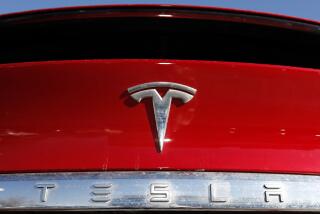Drivers Complain of a Glaring Problem
- Share via
Given the level of apathy in this country, it is noteworthy when a handful of regular Joes (or Janes) take the time to put pen to paper to complain to someone in a position of authority.
But when several hundred people do it, it suggests that a glaring problem is at hand.
That brings us to the flurry of letters and e-mails that have inundated government officials and others over the problem of nighttime glare from car headlights.
After receiving a handful of informal complaints, the National Highway Traffic Safety Administration made a formal request last year for public comment. Word of the agency’s request was spread by newspapers, radio and television.
The response: More than 1,700 letters and e-mails in five months--one of the largest public responses to an NHTSA request in years. The headlight glare problem attracted more complaints than such topics as air bags and window tinting.
“Nothing in recent memory has attracted as many comments,” said Elly Martin, a spokeswoman for the agency. “This has been an outpouring of individuals.”
The letters and e-mails have primarily come in two categories: complaints about ubiquitous sport utility vehicles, many of which have headlights mounted so high that they shine directly into the bleary eyes of the drivers of sedans, and complaints about new high-intensity, blue-tinged headlights installed on many luxury cars.
The problem with SUV lights may be the easiest to address.
Most SUVs ride high for extra clearance, even if the closest most urban drivers get to an off-road experience is when they drive onto their lawns to wash the car.
“Whether an SUV or truck is approaching or driving behind my car, it is difficult to see and quite disabling,” Deborah J. Callis of San Francisco said in her letter.
Automobile manufacturers and vehicle safety experts have already suggested that lawmakers lower the mounting height of headlights from the current maximum of 54 inches off the ground. That height limit has been in place since 1968.
The Alliance of Automotive Manufacturers has recommended lowering it to 47 inches. The Society of Automotive Engineers has suggested bring it down even farther, to about 39 inches.
That may solve the problem with new SUVs, but it would do nothing to address the millions of older behemoths roaming the streets. In 2000, SUVs, light trucks and vans represented 50% of all new vehicle sales. That’s 8 million big-wheeled, high-riding machines using their intrusive beams on the nation’s roads.
The second category of complaints--glare from the extra bright, bluish headlamps--may be more difficult to solve.
The manufacturers of such lights--called high-intensity discharge lamps--claim the headlights are up to three times brighter than typical halogen headlamps, use less energy and will last nearly the entire life of the car.
Auto makers say such lights are the headlamps of the future. They are already installed on newer Lexus, Cadillac, GMC truck and Volkswagen Beetle models, among others. Several companies also sell retrofit kits to install the lights on older cars.
Those headlights operate in much the same way as mercury vapor and sodium vapor lights used as street lamps and outdoor lighting for stadiums, except that xenon gas is often used to eliminate a slow start-up.
The NHTSA has yet to find data suggesting that the bluish-white lights are so distracting that they cause serious accidents. But many motorists have complained that the lights are annoying, distracting and even blinding.
Robert Eggers, a retired engineer from San Jose, complained to the NHTSA, saying the high-intensity lights “make it very difficult to see traffic ahead.”
In an interview, he said: “You have to look the other way and try to avoid them.”
Eggers, who drives an old Jeep Cherokee, believes most motorists get the new headlamps for the prestige of having the latest fancy accessory. “I think it’s all just a matter of selling jazziness,” he said.
Steven Koeppel of Palm Springs agrees. He wrote to the NHTSA saying: “They’re just another status symbol, and they are definitely road hazards.”
Virginia Howell of Richwood, N.J., claimed in a letter that the glare of the high-intensity discharge lights has forced her to swerve off the road. “I am literally blinded by the glare of these new lamps during the day and at night,” she said.
Car makers blame such complaints on cheap knockoffs installed by amateur mechanics.
Rob Strassburger, vice president of vehicle safety for the Alliance of Automobile Manufacturers, said the factory-installed headlights meet federal standards and have yet to be linked to any accidents.
Strassburger, whose own car is equipped with high-intensity lights, said the new headlamps improve visibility for drivers. Several university studies support Strassburger’s claim. But even Strassburger concedes that the new headlights can be annoying to oncoming drivers.
He suggests that some complaints have come from drivers who stare at the headlights because of the bluish color.
“The fact that they are different is making people take notice,” he said.
Strassburger’s theory has precedent. When halogen headlights were introduced in 1979, hundreds of motorists complained to the media and the government about their intensity.
One possible solution to the glare problem is to adopt a European approach: allowing the headlamps only on vehicles with automatic aiming devices and headlight wipers. The aiming systems keep the beam of light focused on the road--not on the faces of oncoming drivers. The wipers help eliminate dirty lenses, which disperse the intense light.
The NHTSA is reviewing the letters and e-mails and analyzing all relevant studies on the problem before deciding whether to adopt new standards.
But there are signs that the agency has seen the light.
Administrator Jeffrey Runge said of the outpouring of complaints: “We expect that our request for comments will elicit useful information that will lead to better lights with less glare.”
*
If you have questions, comments or story ideas regarding driving or traffic in Southern California, send an e-mail to behindthewheel@ latimes.com.







